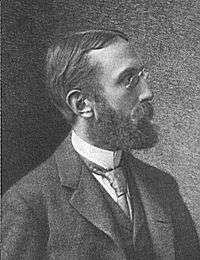Charles Eliot (landscape architect)
| Charles Eliot | |
|---|---|
 | |
| Born |
November 1, 1859 Cambridge, Massachusetts, USA |
| Died |
March 25, 1897 (aged 37) Brookline, Massachusetts, USA |
| Cause of death | Spinal meningitis |
| Nationality | American |
| Occupation | Landscape architect |
| Known for | Metropolitan Park System of Greater Boston |
| Parent(s) |
Charles William Eliot Ellen Derby Peabody |
| Relatives | Eliot family |
Charles Eliot (November 1, 1859 – March 25, 1897) was an American landscape architect, known for pioneering principles of regional planning and laying the groundwork for conservancies across the world. He played a central role in shaping the Boston Metropolitan Park System, designed a number of public and private landscapes, and wrote prolifically on a variety of topics.[1]
History
Eliot was born in Cambridge, Massachusetts in 1859 to Charles W. Eliot and Ellen Derby Peabody. His father became President of Harvard University in 1869, the same year his mother died. He was part of the Eliot family, a prominent family originating from Boston. His father's cousin, Charles Eliot Norton, was professor of art history at Harvard, and a well-known literary figure. On graduation from Harvard in 1882, Eliot pursued horticultural courses at the Bussey Institute at Harvard to prepare himself for the profession of landscape architecture.
In 1883 Eliot became an apprentice for Frederick Law Olmsted and Company, where he worked on designs for Cushing Island, Maine (1883), Franklin Park (1884), the Arnold Arboretum (1885), and the Fens (1883) in Boston, and Belle Isle Park (1884) in Detroit. In 1885, on Olmsted's advice, Eliot traveled to Europe to observe natural scenery as well as the landscape designs of Capability Brown, Humphry Repton, Joseph Paxton, and Prince Hermann von Pückler-Muskau. Eliot's travel diaries provide one of the best visual assessments of European landscapes in the late 19th century.
Returning to Boston in 1886, Eliot opened his own office. His commissions included White Park (1888) in Concord, New Hampshire, Youngstown Gorge (1891), now called Mill Creek Park, in Youngstown, Ohio, and Salt Lake City's plan for a new town (1890).
On March 5, 1890, Eliot published an article entitled "Waverly Oaks" to defend a stand of virgin trees in Belmont, Massachusetts, in the process making a plea for preservation of the oaks and outlining a strategy for conserving other areas of scenic beauty in the same way that the Boston Public Library held books and the Museum of Fine Arts pictures. This article resulted in a conference held at the Massachusetts Institute of Technology in 1890 on preservation of scenic beauty, and led to the enactment of Massachusetts legislation creating The Trustees of Reservations in 1891 — the world's first organization created to "acquire, hold, protect and administer, for the benefit of the public, beautiful and historical places." Within four years, Britain's National Trust was created along these lines.
After the death of their partner Henry Sargent Codman, Olmsted's son Frederick Law Olmsted, Jr. and stepson John Charles Olmsted asked Eliot to become a full partner in their firm. In March 1893, the firm's name was changed to Olmsted, Olmsted and Eliot. Within a few months, Eliot assumed the leadership role as the elder Olmsted's health continued to fail.
Eliot died March 25, 1897, at age 37 from spinal meningitis.
Legacy

Eliot's work has left a lasting mark on greater Boston. He published conceptual plans for the esplanades along the Charles River in Boston proposed earlier by Charles Davenport and others, and as the consulting landscape architect for the Metropolitan Park Commission, he supervised the acquisition of much of the riverfront in Boston, Watertown, and Newton. He also directed the landscape work on the Cambridge esplanade for the city's park commission. The esplanade in Boston was later realized following designs by Guy Lowell (1910) and Arthur Shurcliff (1936).[2] In 1883, he designed Longfellow Park between the Cambridge home of Henry Wadsworth Longfellow and the Charles River. Up until his death he was the partner in charge of the firm's work at Fresh Pond in Cambridge.
In addition to his practice, Eliot became a regular contributor of professional articles to Garden and Forest Magazine.
After Eliot's death, Olmsted's son and stepson reconstituted their partnership as the Olmsted Brothers, which continued for a half-century as one of the best-known landscape design firms in the United States, and went on to design thousands of parks, gardens, and landscapes in the 20th century.
Eliot's writings have been characterized as the inspiration behind the establishment of Acadia National Park on Mount Desert Island in Maine.[3]
See also
References
- ↑ Charles W. Eliot (1902). Charles Eliot, Landscape Architect.
- ↑ Inventing the Charles River, Karl Haglund, 2003
- ↑ "Hancock Country Trustees of Public Reservations". National Park Service. Retrieved 2013-01-04.
The story of Acadia National Park's creation begins a hundred years ago on a cold winter day in the Boston home of Charles W. Eliot, president emeritus of Harvard University, and a summer resident of Mount Desert Island.
Further reading
- Eliot, Charles William (1999). Charles Eliot, Landscape Architect. University of Massachusetts Press. ISBN 1558492127.